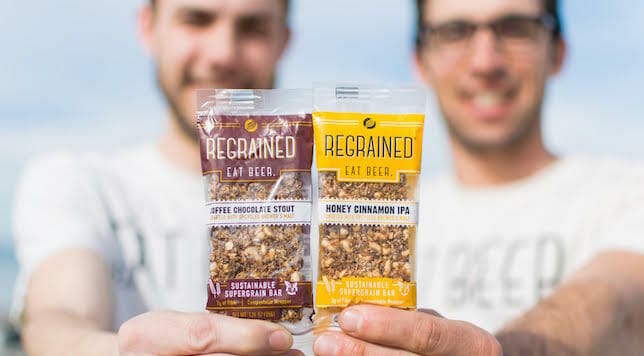These Food Bars Keep Spent Brewer’s Malt Out of the Landfill
Photos courtesy of ReBrained
We’e heard a lot about food in beer (beets, ginger, chocolate, orange peel, it goes on.) But what about food made from beer?
A pair of California entrepreneurs started baking bread in their frat house at UCLA using the spent grain from their home brewing experiments. They grew that enterprise into a company they called ReGrained. It’s part of a growing “food upcycling” movement.
“Brewers aren’t wasteful, you just can’t make beer without using a bunch of grain,” said Dan Kurzrock, co-founder of ReGrained. “So we see our role as creating this platform between the brewing and the food system. We can have a service for the breweries, saving them disposal cost on getting rid of the grain and upcycling it to the highest use, which in our opinion is feeding people directly.”
The majority of brewers in this country still work with farmers who can use brewer’s malt for animal feed, but with the growth in craft beer (two new breweries a day!) and urbanization of the craft beer movement, there are more and more breweries in cities that don’t have farmers coming to get the grain.
ReGrained currently works with San Francisco beermakers 21st Amendment Brewing, Fort Point Beer Company, Harmonic Brewing, Magnolia Brewing, Thirsty Bear Organic Brewery and Triple Voodoo Brewery.
They collect spent grain from barley-based beers, which is most beers.
“Even though there’s a lot of different styles of beer, most of the malts are barley malts,” Kurzrock said. “It’s pretty consistent.”
Now, some brewers say you wouldn’t want to eat used brewer’s malt because all the sugar has been used up in the fermenting process. Kurzrock acknowledges that the mash is not sweet, but it’s not particularly sour or bitter either.
“It just tastes like kind of flavorless oatmeal. I wouldn’t eat spoonfuls of it but as a core ingredient it’s quite impressive: anything you’re adding it to, it’s going to increase the fiber it’s going to increase the protein and it’s going to decrease the sugar. Chefs actually really like it because it’s not completely neutral, it has kind of a nutty flavor to it.”
The company currently offers chewy food bars (“kind of like a healthy Rice Krispies treat,” Kurzrock says) and plans to launch a flour product, milled from the brewer’s malt.
They’re even developing a patented drying system, doing the R&D at a USDA facility near Berkeley, to dry the malt before milling it into flour. The system is energy-efficient and preserves nutrients well, he said.
-

-

-

-

-

-

-

-

-

-

-

-

-

-

-

-

-

-

-

-

-

-

-

-

-

-

-

-

-

-

-

-

-

-

-

-

-

-

-

-

 Photo courtesy of ReGrained
Photo courtesy of ReGrained






































